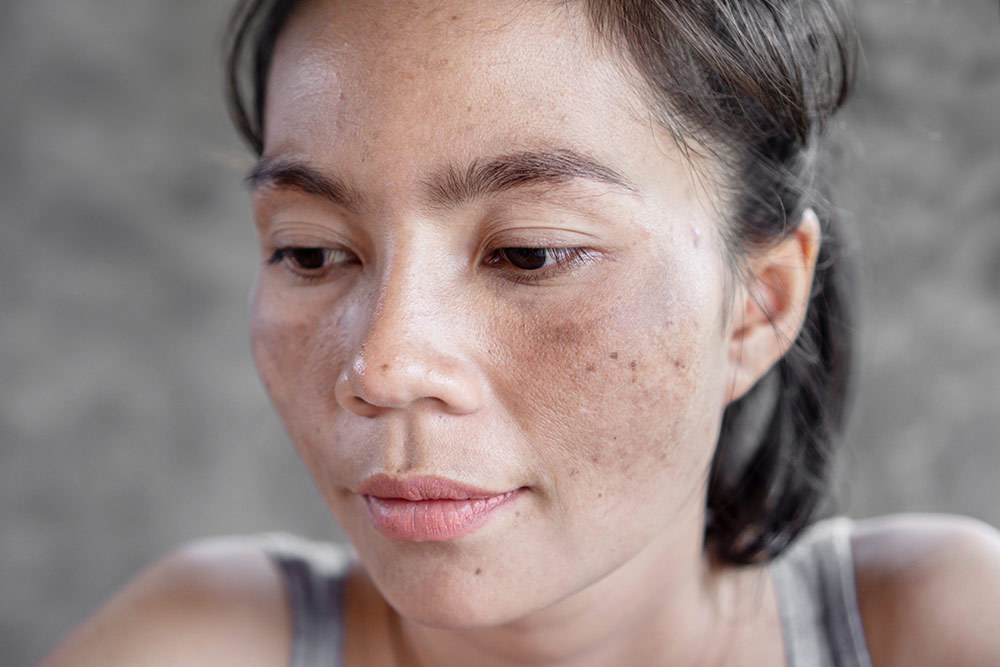What Is Melasma and How Can You Treat It?

It’s all hormones and sunshine.
By Ashley Ziegler
Medical Experts: Alissa Conklin, MD; Patricia K. Farris, MD; Edidiong Kaminska, MD, MBS; Lauren Eckert Ploch, MD, MEd, FAAD
Some women carry pregnancy really well. Their hair is shiny, skin is clear, they manage to avoid all of the swelling, and they rock a form-fitting pregnancy dress like nobody’s business. I was not one of these women. Not only was my experience pretty much the opposite of everything I just listed, but also, instead of the “pregnancy glow” I was promised, dark spots suddenly appeared all over my face.
I experienced what the American College of Obstetricians and Gynecologists (ACOG) calls “the mask of pregnancy,” or melasma, a skin condition that likes to rear its ugly head during pregnancy. I am by no means alone in this either, as melasma affects up to 50% of pregnant women. Read on to learn more about this common skin condition—including tips for prevention.
What is Melasma?
“Melasma is a common, recurring disorder of hyperpigmentation of the skin,” explains Alissa Conklin, MD, an OB-GYN with Indiana University Health, “It occurs due to melanocytes (the cells in the skin that deposit melanin, the pigment responsible for the color of the skin) depositing excessive amounts of melanin in the upper layers of the skin called the epidermis and dermis.”
Typically, melasma can be found on the face, “on the cheeks, jawline, [upper lip], forehead, or across the bridge of the nose,” says Patricia K. Farris, MD, a dermatologist practicing in Metairie, Louisiana. She further explains that melasma spots and patches are different from acne, moles, and freckles, in that they are usually brown or gray, appear in dark patches, and are irregular in shape.
What is the Cause of Melasma?
While it is commonly referred to as “the mask of pregnancy,” melasma can appear at any time. “Melasma can happen to anyone, including men,” says dermatologist Edidiong Kaminska, MD, MBS, “however, it is far more common in women.”
According to Dr. Conklin, common triggers for this skin discoloration include genetics, “chronic and excessive exposure to sunlight or UV light, zinc deficiency, anti-seizure medications, photosensitizing drugs, and skin phototype (phototypes II and III are more prone to melasma).” Additionally, she says, “visible light (not just UV light) can also cause melasma in people with darker skin types.”
Still, even if it isn’t unique to pregnancy, it’s definitely a concern of many pregnant people. So what gives? Well, it turns out that another major trigger for melasma is a change in hormones (you know, like the ones that affect just about everything in your body during pregnancy).
“Melasma occurs more often during pregnancy because it’s related to both hormones and sun exposure,” says dermatologist Lauren Eckert Ploch, MD, MEd, FAAD. In fact, she says people who take oral contraceptives also often experience melasma as a result of the hormones in them.
Does It Ever Go Away?
The good news with most unpleasant pregnancy symptoms is that with time, they seem to go away once the baby arrives. But does melasma disappear after pregnancy? Well, it’s complicated.
“Melasma often goes away after pregnancy,” says Dr. Conklin, “but once a person gets it they are more prone to it with future activators such as sun exposure or a subsequent pregnancy.”
Basically, those brown patches may clear up in the months following the birth of your baby, but if you spend time in the sun, go on hormonal birth control pills, or experience some other trigger, chances are high that you’ll start seeing dark spots again. If that’s the case, then you might want to look into treatment options (though, treatment isn’t medically necessary because these spots are not harmful).
Treatment of Melasma
If you can’t stand the spots melasma leaves behind, then your dermatologist may be able to offer some help. “A dermatologist can offer melasma patients a variety of effective treatments,” says Dr. Farris, “[Topical] creams containing skin lightening ingredients such as hydroquinone, tranexamic acid, azelaic acid, retinoids, niacinamide, and antioxidants like vitamin C are effective.” Additional options include in-office procedures like chemical peels and laser treatments.
It’s important to note, however, that if you’re trying to fight melasma while you are pregnant or breastfeeding, it’s essential to check with your health care provider before moving forward with any treatment. Not all skin treatments and procedures are safe during these times (in fact, many of them are not), so it’s always better to err on the side of caution.
How to Prevent Melasma During Pregnancy
The best way to prevent (and reduce) the appearance of these dark spots is by practicing basic sun protection. “Sunscreen is your best bet to prevent melasma flares,” says Dr. Kaminska. She specifically recommends broad-spectrum sunscreens with zinc oxide, titanium dioxide, and/or iron (ferrous) oxides.
Of course, Dr. Farris notes, that protective clothing is also helpful in avoiding sun exposure (and triggering melasma spots). So break out your ultraviolet ray-blocking SPF clothing, sun hats, and sunglasses—and don’t forget to stay in the shade as much as possible on sunny days.
Even though melasma is common while expecting if you notice dark spots popping up during pregnancy, be sure to point them out to your health care provider. Dark spots with irregular shapes can also be signs of skin cancer, so it’s important not to assume anything and monitor them for changes just in case.








